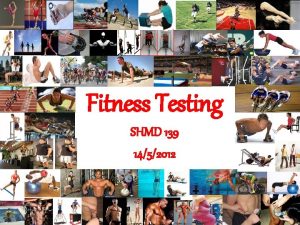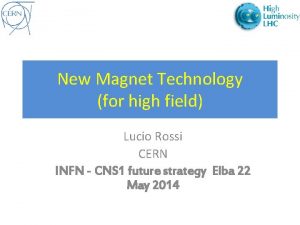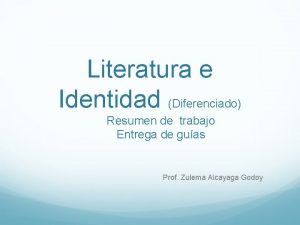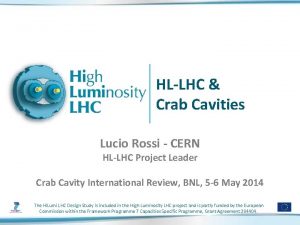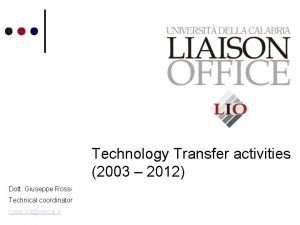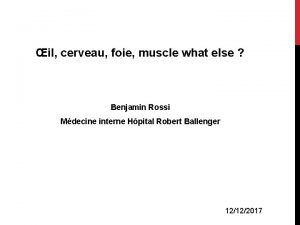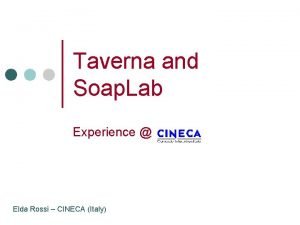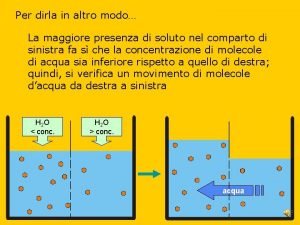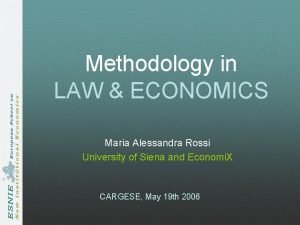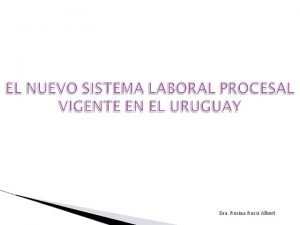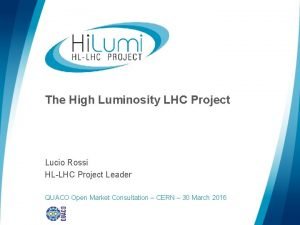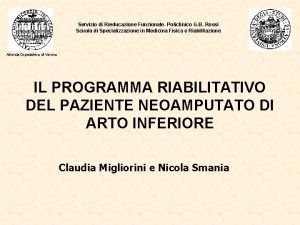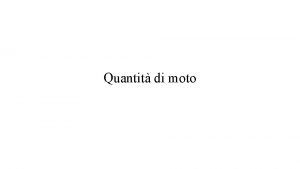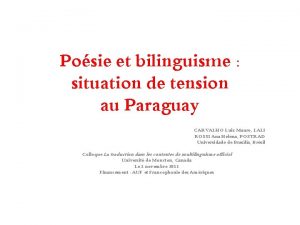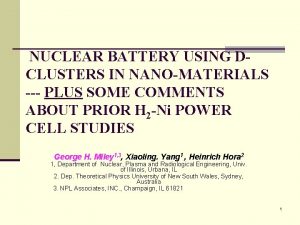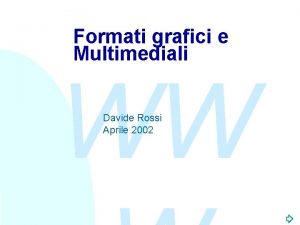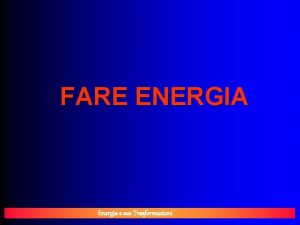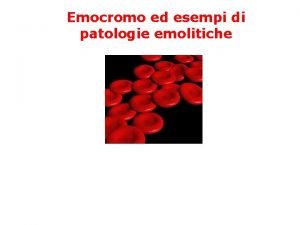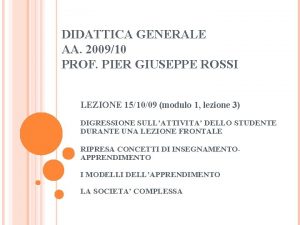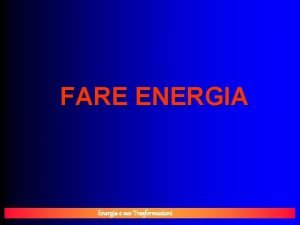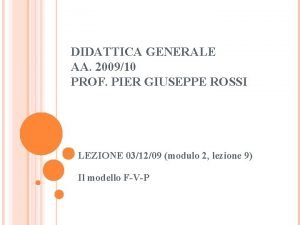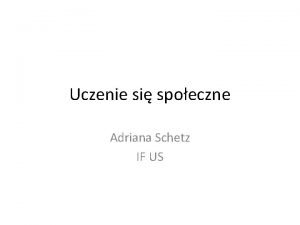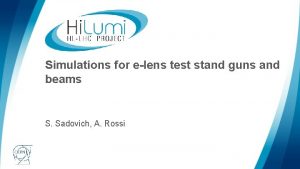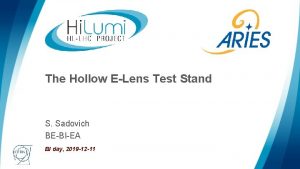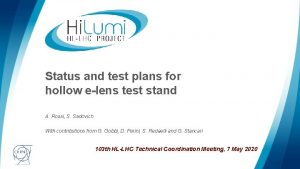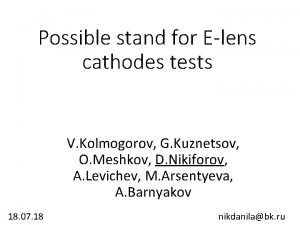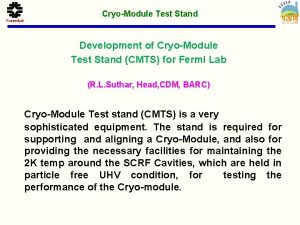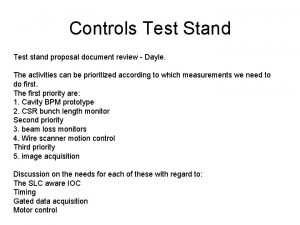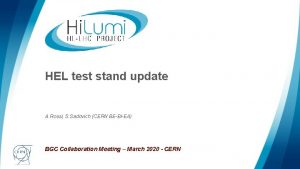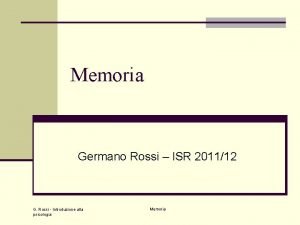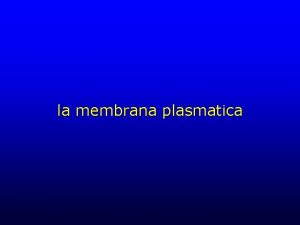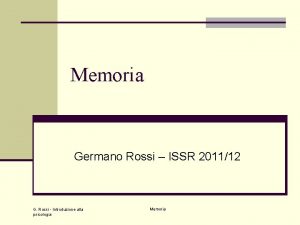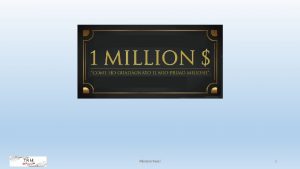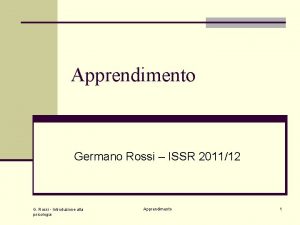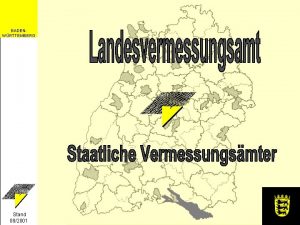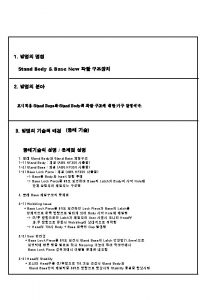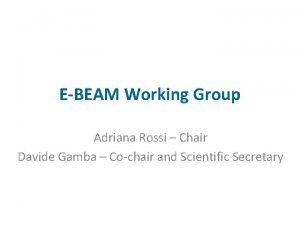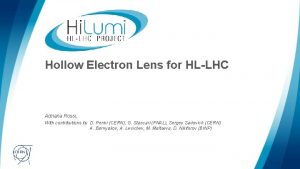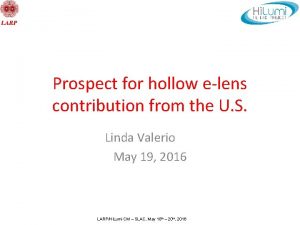Elens test stand at CERN Adriana Rossi CERN


































- Slides: 34

E-lens test stand at CERN Adriana Rossi (CERN BE-BI-EA) With contributions from Alexey Levichev, Danila Nikiforov, Alexey Barnyakov, Mariya Maltseva (BINP), Sergey Sadovich (CERN), Giulio Stancari (FNAL) Mini-workshop on Beam-Beam Effects in Circular Colliders – LBL 5 -7 Feb. 2018 logo area

Outline § Context: electron beam applications § Brief description of electron lenses and electron beam dynamics § Mention to preliminary BBRL e-beam studies § Motivations and description of a test stand at CERN § Summary and outlook logo area A. Rossi, Mini-workshop on Beam-Beam Effects in Circular Colliders, 5 -7 February 2018, LBL Berkeley CA 2

Context Electron beams can be used in conjunction with proton/ion beams for § Electron cooling (for ex. at CERN LEIR, AD, ELENA, GSI SIS 18), § Space charge compensation (GSI SIS 18 *, FNAL IOTA) § Beam-beam compensation (at FNAL Tevatron and BNL RHIC) § Halo diffusion enhancement (at FNAL Tevatron) § At HL-LHC e-lenses are being studied for: § § BBLR for Beam-Beam Long-Range compensation BBHO for Beam-Beam Head-On compensation? HEL for Halo diffusion enhancement Landau damping? (Not needed according to Sasha’s talk) * under study with the ARIES project (Accelerator Research and Innovation for European Science and Society) logo area A. Rossi, Mini-workshop on Beam-Beam Effects in Circular Colliders, 5 -7 February 2018, LBL Berkeley CA 3

Electron beam applications § Electron cooling : shrink emittance (size, divergence, and energy spread = lower the temperature) of a charged particle beam without removing particles from the beam. Electron are injected at the same velocity as the ion/proton beam, via Coulomb scattering they exchange momentum and at thermodynamic equilibrium, since the electrons are much lighter, they will have increased their velocity, and the opposite for the ions/protons. § 5 m. A × ~. 3 k. V electrons, 25 mm, for CERN-ELENA, § 1 A x 7 k. V, 25 mm for GSI-SIS 18 § Space charge compensation : electric field generated by electron beams (Gabor lenses) used to focus ion/proton beams, whose space charge would otherwise cause emittance blow-up. § Electron beam with transverse and longitudinal distribution plus current intensity ~ matching beam to be focused § 10 A average - 20 A peak current, 50 x 70 mm size, 25 k. V for GSI studies logo area A. Rossi, Mini-workshop on Beam-Beam Effects in Circular Colliders, 5 -7 February 2018, LBL Berkeley CA 4

Electron beam applications § Beam-beam compensation: The strongly nonlinear beam-beam force excites high-order betatron resonances, particles diffuse into the tails of the transverse distributions causing emittance growth and beam losses. Beam-beam tune spread might be reduced by: xw yw § for Long-Range Beam-Beam (parasitic encounters) § compensation with e-beam wire § at HL-LHC required electron beam ~ 200 Am (for 2 wires per HL IP) § ~ 60 Am (=20 A x 3 m) × several tens of k. V (2 e-lenses per HL IP) wire like § for Head-On Beam-Beam (IP collisions) § collisions of the proton bunch with a space charge of a low energy e-beam, having the same Gaussian transverse distribution as the p-beam § at RHIC ~0. 2 A proton beam with beam-beam parameter 0. 007 used total of 2 e-lenses with ~2 Am (=1 A × 2 m) × 5 k. V (2 IPs) § HL-LHC ~1. 1 A proton beam with beam-beam parameter 0. 033 ~ 10 Am (scaling with current and e-energy plus 2 e-lenses per HL IP) × 15 -20 k. V logo area A. Rossi, Mini-workshop on Beam-Beam Effects in Circular Colliders, 5 -7 February 2018, LBL Berkeley CA 5

Electron beam applications § Halo diffusion enhancement: Loss spikes have already affected the operation of the LHC, and control of beam losses is recognised as a critical concern for performance at HL-LHC due to the higher beam energies and intensities (for ex. for Crab Cavity failure). § Hollow electron lenses are being designed and (if approved as baseline) will be installed in IR 4 (during LS 3) as active mean to increase diffusion rate of halo particles. Halo § at HL-LHC required hollow electron beam ~ 15 Am (3 m e-lens per beam) 5 A × 15 k. V Courtesy of G. Stancari logo area A. Rossi, Mini-workshop on Beam-Beam Effects in Circular Colliders, 5 -7 February 2018, LBL Berkeley CA 6

Outline § Context: electron beam applications § Brief description of electron lenses and electron beam dynamics § Mentions to some BBRL e-beam studies § Motivations and description of a test stand at CERN § Summary and outlook logo area A. Rossi, Mini-workshop on Beam-Beam Effects in Circular Colliders, 5 -7 February 2018, LBL Berkeley CA 7

Electron Lens schematics (typical values for HEL) Electron gun (A) Modulator (KHz to MHz) Instrumentation BPMs Collector Overlap/transvers profile monitors Main SC solenoid 4 -6 T Gun solenoid > 0. 2 T logo area Bending SC solenoids ~3 T S at LHC - U at Tevatron and RHIC International Review on the e-lens concept readiness for integration into the HL-LHC baseline 19 Oct. 2017 8

Electron beams § An electron in a uniform B field will gyrate along beam lines with § cyclotron frequency § gyroradius § In the presence of an electric field (self field of e-beam), assuming that the induced B field change is << logo area A. Rossi, Mini-workshop on Beam-Beam Effects in Circular Colliders, 5 -7 February 2018, LBL Berkeley CA 9

Electron beam in electron lens Courtesy of Daniel Noll Beam is further compressed : stronger SC several A e-beam ~10 mm @ cathode Beam is compressed and bent logo area In case of azimuthally non-uniform beam there could be an angular component of the electric field causing further beam tilt. A. Rossi, Mini-workshop on Beam-Beam Effects in Circular Colliders, 5 -7 February 2018, LBL Berkeley CA 10

CHG 1 B Ø 25 mm cathode – Ø 63 mm chamber magnetic field in main solenoid (gun solenoid at 0. 2 T) peak collector current [A 1/2] cathode-anode voltage [k. V 1/2] Courtesy of Giulio Stancari logo area 11

Outline § Context: electron beam applications § Brief description of electron lenses and electron beam dynamics § Mentions to some BBRL e-beam studies § Motivations and description of a test stand at CERN § Summary and outlook logo area A. Rossi, Mini-workshop on Beam-Beam Effects in Circular Colliders, 5 -7 February 2018, LBL Berkeley CA 12

HL-LHC layout as from WP 15 Oct. ’ 16 187. 44 m logo area 193. 6 m from IP Note BBLR compensation not in HL-LHC baseline A. Rossi, Mini-workshop on Beam-Beam Effects in Circular Colliders, 5 -7 February 2018, LBL Berkeley CA 13

Assumptions for e-lens simulations for BBLR in HL-LHC (optics v 1. 2) § § Proton beam dimension relevant only in the crossing plane For HL IP 5 (reverse plane for IP 1) B 2, symmetric for B 1 Round Flat § βx (m) σx (mm) βy (m) σy (mm) left 1000 0. 58 2000 0. 82 right 2000 0. 82 1000 0. 58 left 500 0. 41 4000 1. 16 right 1000 0. 58 2000 0. 82 In the simulations by A. Levichev et al. it was assumed an electron beam of Ø 2 mm given space available if electron beam wire placed at 10 σx A. Rossi, Mini-workshop on Beam-Beam Effects in Circular Colliders, 5 -7 February 2018, LBL Berkeley CA 14

Beam dynamics I=20 A, U 0=35 k. V logo area A. Levichev, D. Nikiforov, A. Barnyakov, BINP

Preliminary BBLR electron studies Effect of vacuum chamber geometry Transverse electron profile for a 20 A - 35 k. V source (~1 cm 2). The radial energy distribution and transverse dimensions are shown for 2 different pipe geometries. Note: statistics/meshing probably too low/large to see full dynamics. logo area A. Levichev, D. Nikiforov, A. Barnyakov, BINP

Outline § Context: electron beam applications § Brief description of electron lenses and electron beam dynamics § Mentions to some BBRL e-beam studies § Motivations and description of a test stand at CERN § Summary and outlook logo area A. Rossi, Mini-workshop on Beam-Beam Effects in Circular Colliders, 5 -7 February 2018, LBL Berkeley CA 17

Test facility at CERN § Foreseen for ARIES studies WP 16 – Intense, RF modulated E-beams (IRME) § Design and build a test stand for testing this gun including instrumentation suitable for measuring the transverse and longitudinal profiles of the RF modulated electron beam § Measure the properties of the RF modulated electron beam created by the gun using this test stand 50 x 70 mm oval e-beam, 5 -10 A, 22 k. V for the ion beam at the Heavy Ion Synchtron SIS 18 (to be used as injector to SIS 100) for Space Charge Compensation matched transversally and longitudinally logo area A. Rossi, Mini-workshop on Beam-Beam Effects in Circular Colliders, 5 -7 February 2018, LBL Berkeley CA 18

Test facility at CERN § Foreseen to test high intensity e-gun for Beam-Beam Long Range compensation § § Few mm round e-beam, up to 20 A, 20 -35 k. V Modulated at 40 MHz for bunch by bunch (for BMP measurements) Could be modulated at 4 MHz (102 nd Hi. Lumi WP 2 Meeting) Test Gas Curtain Monitor [see ref. ] § If HEL becomes baseline to do at CERN (15 k. V) § § § Characterise e-guns Validate, commission modulators Test beam instrumentation, modulators, interlocks, Learn safety and technical aspects of e-lenses operation Prepare infrastructure for test and commissioning of components of HEL@LHC logo area A. Rossi, Mini-workshop on Beam-Beam Effects in Circular Colliders, 5 -7 February 2018, LBL Berkeley CA 19

E-lens test stand at FNAL https: //cdcvs. fnal. gov/redmine/projects/elens/wiki/Test_Stand Operational, up to 10 k. V, 8 ms x 1 Hz pulses (or higher at < 5 A) Used to test CERN guns, will be used for testing guns for space-charge compensation at IOTA ring. Could be used to test HF modulators. 20

G. Stancari FNAL – WARP code G. Stancari FNAL A. Levichev et al. BINP – Ultra. SAM code A. Pikin BNL TRACK code Electron gun characterisation 21

Test-stand development at CERN: Basic configuration – stage 1 Up to 0. 2 T Example of diagnostic box at RHIC e-lenses Up to 0. 42 T (400 A) magnets at CERN Purpose of this stage: Gun solenoid (twins), collector solenoid, diagnostic box (pin-hole Faraday cup with bias V [distribution and energy] + YAG screen monitor), 40 HV system. § Preparation: § Commissioning diagnostic procedures (current, profile, position) § Commissioning HV system § Safety and technical aspects of operation § § § Electron gun tests: characterization & simulations Design diagnostic box Tests with Beam Gas Curtain monitor A. Rossi, Mini-workshop on Beam-Beam Effects in Circular Colliders, 5 -7 February 2018, LBL Berkeley CA 22

Test-stand development at CERN. Upgrade Addition of main solenoid – stage 2 Main solenoid could be 0. 4 -0. 5 T x 1. 2 m or higher (in the latter case a dry SC solenoid may be cheaper and would expand range of investigation) Purpose of this stage: § § § Allow drift and see beam deformations/rotations/… Test Beam Position Monitor ‘shoe-box’ or ‘strip-line’ with very HF modulation Test effect of very HF modulation (~10% current) on beam dynamics (microbunching? ) Study electron beam dynamics in regime close to virtual cathode Computer model validation Study electron beam dynamics with compression or pushing current A. Rossi, Mini-workshop on Beam-Beam Effects in Circular Colliders, 5 -7 February 2018, LBL Berkeley CA 23

Test-stand development at CERN. The future! Addition a bend – stage 3 Purpose of this stage: • Measure effect of B x grad. B on deformation of beam with high current density • Computer model validation A. Rossi, Mini-workshop on Beam-Beam Effects in Circular Colliders, 5 -7 February 2018, LBL Berkeley CA 24

Summary and outlook § A test stand at CERN is being constructed in a phased approached. § Phase 1 it will be/ can be used to: § E-gun characterisation both for HL-LHC HEL (in parallel or after FNAL) and SIS 18 SCC lens. § E-guns for BBLR compensation lenses. § Test and commission BGC [see ref. ] § Phase 2 needed to: § Test RF modulation for SIS 18 SCC lens. § Test BPM for electrons (HF or LF modulation). § Investigate electron beam dynamics and benchmark simulation codes like CST, WARP, Ultra. SAM, … logo area A. Rossi, Mini-workshop on Beam-Beam Effects in Circular Colliders, 5 -7 February 2018, LBL Berkeley CA 25

Thank you for your attention References for Beam Gas Curtain (or Jet) monitor: H. Zhang et al, DEVELOPMENT OF A SUPERSONIC GAS JET BEAM PROFILE MONITOR, IBIC 2015 V. Tzoganis et al, EXPERIMENTAL RESULTS OF A GAS JET BASED BEAM PROFILE MONITOR, IPAC 14 V. Tzoganis et al, Design and first operation of a supersonic gas jet based beam profile monitor, Phys. Rev. Accel. Beams 20, 062801, 12 June 2017 logo area 26

Spare slides logo area A. Rossi, Mini-workshop on Beam-Beam Effects in Circular Colliders, 5 -7 February 2018, LBL Berkeley CA 27

Hollow Electron Lens Collector Electron gun 5 Ax 15 -20 k. V VCA Cathode Heater 10 Ax 40 V cathode grid anode + Control electrode 4 k. Vx 40 m. A – + + Anode modulator – VCA≤ 20 k. V, Ianode 33 k. Hz, 200 ns rise time – – Cathode PC logo area + VCO Anode/grid modulator 40 MHz High voltage (15 -20 k. V) low current (losses) VCA, Itube – Cathode – Collector PC + High voltage (~15 k. V) High current VCA-VCO, Ibeam=5 A 28

Electron Lens schematics (typical values) Electron gun (A) Modulator (KHz to MHz) Collector Main SC solenoid 4 -6 T Gun solenoid > 0. 2 T logo area Bending SC solenoids ~3 T A. Rossi, Mini-workshop on Beam-Beam Effects in Circular Colliders, 5 -7 February 2018, LBL Berkeley CA 29

Effect of drift velocity BINP CST simulation of a 5 A beam x 12 k. V deforming along the HEL (BINP) in 4 T solenoid Space charge dominates and deteriorates beam shape over 3 m logo area A. Levichev, D. Nikiforov, A. Barnyakov, M. Maltseva , BINP 30

Effect of larger e-beam potential and B (I=4 A, U 0=10 k. V) Beam profiles close to the beginning (left) of the main solenoid (4 T) and the end (right) BINP (I=4 A, U 0=12 k. V) Beam profiles close to the beginning (left) of the main solenoid (6 T) and the end (right) Higher B = lower rotation velocity Higher accelerating potential (larger than the perveance limit) helps. Larger main solenoid magnetic field stabilises the e-beam further. logo area A. Levichev, D. Nikiforov, A. Barnyakov, M. Maltseva , BINP 31

BBLR electron studies Beam dynamics I=20 A, V=10 k. V A. Levichev, D. Nikiforov, A. Barnyakov, BINP 32

logo area 33

Existing electron lenses and HL-LHC hollow electron lenses logo area O. Brüning, Chamonix LHC Performance Workshop 2018 34
 Sit and reach measurement
Sit and reach measurement Stand up stand up for jesus
Stand up stand up for jesus Nanny shine
Nanny shine Lucio rossi
Lucio rossi Crianzas cristina peri rossi analisis
Crianzas cristina peri rossi analisis Lucio rossi
Lucio rossi Paulo rossi menezes
Paulo rossi menezes Globuli südtirol
Globuli südtirol Elia rossi passavanti
Elia rossi passavanti Rossi sanusi
Rossi sanusi Giuseppe rossi unical
Giuseppe rossi unical Sindrome de moebius
Sindrome de moebius Sarcoidosis
Sarcoidosis Endopthalmie
Endopthalmie Taverna workbench
Taverna workbench Andrea rossi ecat
Andrea rossi ecat Plasmolisi globuli rossi
Plasmolisi globuli rossi Maria alessandra rossi
Maria alessandra rossi Nicolo baldini rossi
Nicolo baldini rossi Rossi albert
Rossi albert Petit papa noel tino rossi
Petit papa noel tino rossi Palmares rossi
Palmares rossi Lumi rossi
Lumi rossi Incidente carlo talamo
Incidente carlo talamo L'auto del signor rossi ferma al semaforo
L'auto del signor rossi ferma al semaforo Lali rossi
Lali rossi Lenr rossi
Lenr rossi Rossi aprile
Rossi aprile Sue
Sue Anemia mediterranea portatore sano
Anemia mediterranea portatore sano Pier giuseppe rossi
Pier giuseppe rossi Tpn calculation
Tpn calculation Fusione fredda rossi
Fusione fredda rossi Pier giuseppe rossi
Pier giuseppe rossi Adriana schetz
Adriana schetz
